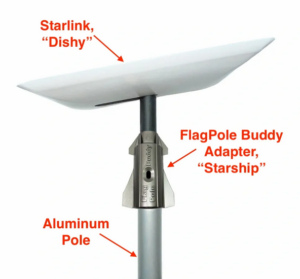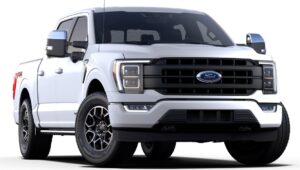While on the road and at the campsite, our internet is used to work, video conference, and stream TV. We’d also like to use our Furbo to keep an eye on our pets, Layla and Lucy, and to dispense the occasional treat. Of course, Layla will never let Lucy eat the treats, but it’s the thought that counts. Speaking of streaming TV, we’ve run into an issue with Hulu limiting service to only our “home” zip code. Although the problem only occurs on the smart TV that came with the rig, not our phones, it’s still pretty annoying. Anyway, here’s how we plan to keep WiFi fast and consistent on the road.
Starlink
We got Starlink for RV when it was released in 2022. The cost is $135/mo ($35 more than home service), but it can be suspended and reactivated at any time, so we only pay when we’re traveling. Service is month-to-month, which means we are billed for a full month, even if we only use it for a few days.
At first, we thought we could just put the Starlink Dishy on the RV roof using the small stand that comes it. Yeah, the satellite dish is called a “dishy”. I don’t say that out loud in public. The RV roof setup would probably work fine, but I really didn’t want to climb the ladder twice at every stop while holding the valuable hardware. Also, wind was also a concern. This could be mitigated with zip ties, but we were still looking for a better solution overall.

We decided to purchase the Starlink Ladder Mount (Gen 2) from Flag Pole Buddy. This mount is easy to install and easy to use, no ladder climbing required after the initial installation. The price has gone up a little, but the kit now includes a bag for storing the poles (we just use the box it was shipped in), cable clamps, and the molded plastic Starlink Dishy mount is now shaped like Elon Musk’s Starship.
We’ve already used this setup a few times and the service and speed has been great! Downside of Starlink, it requires a clear view of the sky. In dense forest, a backup internet provider will be needed. Setup is simple and the shipping box serves as excellent storage for the dishy, stand, router, and 2 cables. There’s also a very solid custom storage solution that can be made using a Husky 12 Gallon Professional Storage container from Home Depot. We’ll probably head this direction later this year.
iPhone Tethering
5G service has made mobile tethering (sharing a phone’s cellular internet connection) a viable option for remote work and streaming TV. Even though we’re on an unlimited plan with AT&T, there is still a 50 GB tethering limit (per device, I think). We’ll have to keep an eye on our usage and I’m not confident that it we be reliable enough to video conference. In addition, it’s a little inconvenient to have the internet service depend on a device that frequently leaves the rig.
FordPass Connect

We signed up for the trial of AT&T Vehicle Service included with the purchase of a new vehicle. It includes service for 3 months with a limit of 3 GB. Hopefully, that’s 3 GB per month, but we haven’t verified that. Also, I think the truck needs to be running for this to work. We use our truck generator to power the rig when we boondock, so vehicle wifi service might be a good way to avoid needing to set up Starlink during short overnight stays.
AT&T says the range is up to 50 ft. That should cover the length of the rig when the truck is connected or parked very close.
Dedicated Hotspot
We don’t have one of these.
